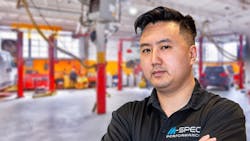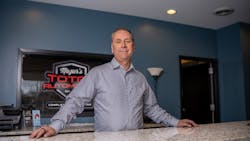When Joe Mazur wanted to test the readiness of his shop leadership team before adding another location, he packed his bags and left Michigan for Florida and allowed his team to run the store on their own for a month.
“I had a super strong manager that had come to work for me. He had only been with me a couple of years, but he could pretty much run the day-to-day operations,” Mazur says.
Upon returning, Mazur observed that the store did well—performing at an 85% to 90% level while maintaining sales, profit and not upsetting customers.
He says while he and his team identified a few holes, he was happy overall, and his concept was proven—his people were ready to operate another store.
“If you can't leave your store and check in once a week for a month and have that store stay where you need it to be, then don't even think about opening a second store,” Mazur says.
Going from Single to Multilocation
When Mazur opened the second location of Mazur's Total Automotive, an acquisition, he trusted that his manager knew the business, was comfortable running the shop and was all in on the shop's philosophy. Given that it was an acquisition, having the right person spearhead it was everything.
"We took over an existing shop and that was really where my trial by fire started. I learned a lot during that time and it reinforced how important people are—people you can trust, who understand not only your processes and procedures but ultimately your why of why you do business,” says Mazur.
He calls it one of the toughest times of his life; harder than opening his first location. It’s an experience he can look back on and laugh at today in light of how much time it took to go from shop two (2012) to shop three (2020).
"I joke around that it took me eight more years to go ahead and do store three because of the trauma,” laughs Mazur, who has opened three more shops between 2020 and 2022.
Creating a Model for Internal Leadership Development
Mazur says his approach to shop leadership is selecting from within his ranks from those whom he has trained and brought up through the business. Once trained, that person then trains their replacement. Once a new store opening becomes apparent, they begin moving personnel to the next location.
"I want to have a manager and a lead technician that I can move (between stores). If I only have to choose one, I'll take the store manager. And our business model is quite a bit different ... We spend a fair amount of time training and mentoring our managers so that they get it and carry on what we do,” Mazur says.
He says while the "each one, teach one" method yields the results he’s looking for, he’s flexible with managers who wish to remain at their current shops.
"Each manager or leader is different. If I have a store manager that is comfortable in the store and likes where he's at and doesn't want to move, well I'm not going force him to move, but he'll help to train the manager that might move on and go to the next store,” Mazur says.
The ideology is the same regarding promoting lead technicians into new stores.
Becoming a multi-shop owner for Mazur isn’t about pride or even largely about the financial benefits, but about being an economic source for his team. He says developing leaders provides more opportunities for people who want to come up the ranks and have a career path with Mazur’s Total Automotive.
"It's my responsibility to keep growing the company so that there are opportunities for these people because otherwise somebody is going to plateau, and if I don't have somewhere for them to move to, they're going to go somewhere else,” Mazur says.
A Different Approach
Auto repair shop owner Adam Liu of M-Spec Performance has three shops in Queens, New York. An industry outsider before becoming a multi-shop owner, Liu says he learned to effectively build his business through his hardships and those lessons taught him what to look for in his managers.
"You have to have a solid foundation, and that foundation is the culture you cultivate in the business,” says Liu.
Liu initially built the shop’s personnel through a combination of Craigslist ads and posting on forums when forums were popular.
“We grew it organically in that matter, but at the same time, we had no idea what we were doing. We didn't know what to charge. We didn't know how to make money. We didn't know the importance of a lot of other things like appearances, and a lot of little nuanced things,” Liu says.
After an a-ha moment, he added a second location after five years in his first. Admittedly, he doesn’t recall the exact moment when it all came together for him but believes it happened at a WorldPac event.
"I ended up going to a class. I don't remember exactly what class it was, but it was a discussion of simple, basic stuff that every shop owner should know, like parts margins, how to sell a ticket. And I was the only person up front and so I ended up learning a few things in that class, implementing them right away, saw that there was a big difference,” Liu says.
After witnessing the return on investment from the applied knowledge taken from the class, he got coached through Transformers. That’s where the idea of going multi-shop came from.
"I remember going to a Ratchet+Wrench conference. Greg Bunch reached out and was like, 'I'm forming this group that is for multi-shop owners. If you want to be a multi-shop shop owner, then you should come.’ Once I started getting those meetings and networking with other multi-shop owners—seeing the potential in the industry, the potential in what we could do, eventually realizing the potential that we could provide for our team, the kind of growth path that we could have for our team—that was a motivating factor,” says Liu.
New York State of Mind
Today, Liu has three shops in New York City, where he says space is constrained and he stays plenty busy. He’s able to focus on growing the business because he has managers installed who believe in the mission and vision of the company. He says letting go enables him to do what he does best, be a visionary leader.
“I do not like to be a micromanager at all. I love being more of a macro person,” Liu says, pointing out that communication and understanding take on a different meaning for New Yorkers.
“We have a very different way of speaking to each other, I guess maybe it's a shop thing, but we're also from New York, so we're very blunt when we talk,” he says.
Communication is to the point, leaders need to have thick skin, and he takes an extreme ownership approach, which is inspired by the Jocko Willink and Leif Babin book of the same title, which he encourages his team to read.
“One of the things I wanted to tell my guys is I'm 100% trying to grow people beyond me and I want to make (fewer) decisions. So, having written systems and processes and having them read them and use them is important,” Liu says.
When it comes to installing managers in new locations, “you either have trusted people or you don't,” and if the latter, you’ll need to look at your structure, your training or your processes and figure out why. And just because a manager makes errors doesn’t mean he’s the wrong guy. Continue to teach.
“I give a lot of freedom to my leaders to also make mistakes, too. I don't necessarily chastise anybody for making mistakes, if it's something that they should have known, then we'll have a conversation about it. If they make a mistake that wasn't anything that anybody had covered, and they made a decision, that's fine. I like when people make decisions, especially if they've gone through the right kind of process,” Liu says.
Shop Growth Must Be a Shared Value
What matters most to Liu is successfully staffing his leadership positions in each store with take-charge type of people who require no hand holding, feel confident in the choices they make and deliver the level of service to customers that are part and parcel of the mission of M-Spec Performance. One of the best lessons Liu learned that he feels is noteworthy is that growth must be a shared value of the team.
“Well, I think No. 1, look at your single store location and see if you have leadership in place there as a one single store location. Secondly, I think that it has to be something that your single store location and all your team there is behind. I've made this mistake before when we went multilocation. I don't think everybody on our team was necessarily behind it, and that caused some early road bumps. The important part is not to fool yourself that everybody is on board with it, right?” Liu says. “Because what got you that single store success, you have to be able to recreate it.”
About the Author
Chris Jones
Group Editorial Director
Chris Jones is group editorial director for the Vehicle Service & Repair Group at EndeavorB2B.
A multiple-award-winning editor and journalist, and a certified project manager, he provides editorial leadership for the auto care industry's most trusted automotive repair publications—Ratchet+Wrench, Modern Tire Dealer, National Oil & Lube News, FenderBender, ABRN, Professional Distributor, PTEN, Motor Age, and Aftermarket Business World.
Subscribe to receive news and updates from any of these industry-leading brands.



